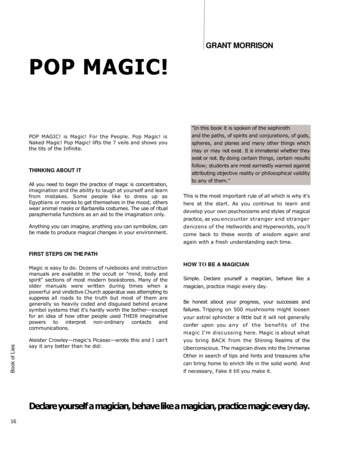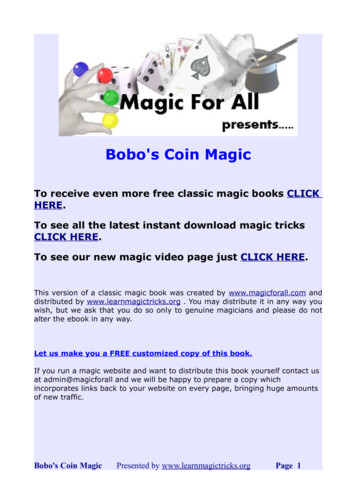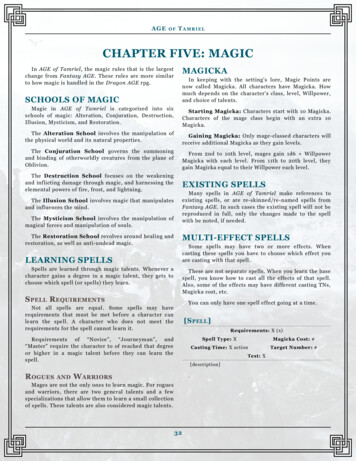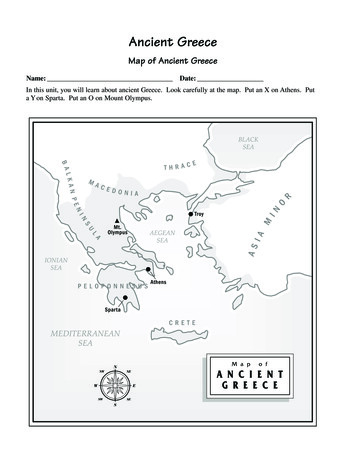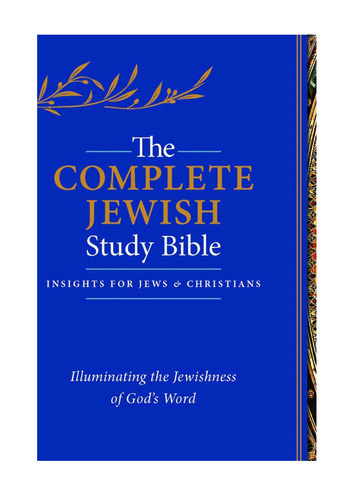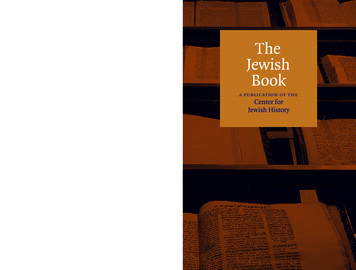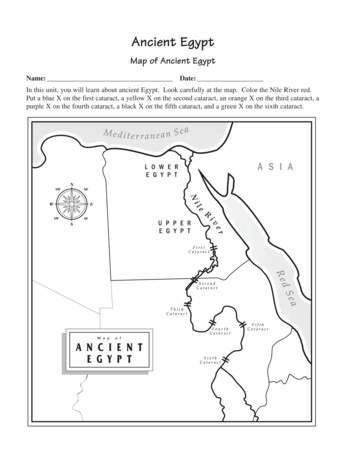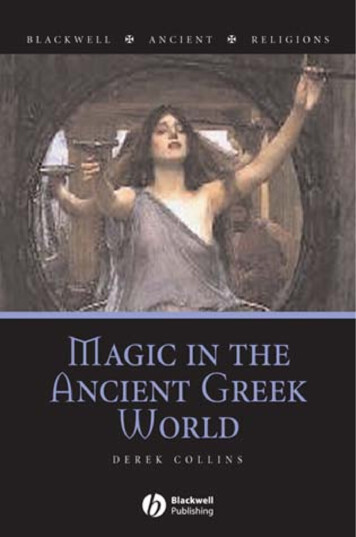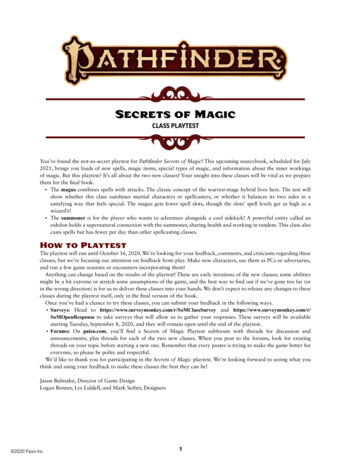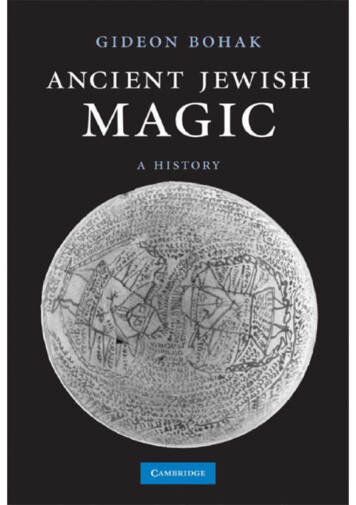
Transcription
ANCIENT JEWISH MAGICThis is a pioneering attempt to write a broad history of ancient Jewishmagic, from the Second Temple to the rabbinic period. It is based bothon the ancient magicians’ own compositions (and products) in Aramaic, Hebrew, and Greek, and on the descriptions and prescriptionsof non-magicians, in an effort to reconstruct a historical picture that isas balanced and nuanced as possible. The book’s main focus is on thecultural make-up of ancient Jewish magic, with special attention paidto processes of cross-cultural contacts and borrowings between Jewsand non-Jews and to inner-Jewish creativity. Other major issues arethe place of magic within ancient Jewish society, contemporary Jewishattitudes to magic and the identity of its practitioners. Throughout,it seeks to explain the methodological underpinnings of all soundresearch in this demanding field, and to point out areas where furtherresearch is likely to prove fruitful.gid eo n b o ha k teaches in the Department of Jewish Culture,University of Tel Aviv. He is author of Joseph and Aseneth and theJewish Temple in Heliopolis (1996).
ANCIENT JEWISH MAGICA HistoryGIDEON BOHAK
c a m b r i d g e u n i ve r s i t y p re s sCambridge, New York, Melbourne, Madrid, Cape Town, Singapore, São Paulo, DelhiCambridge University PressThe Edinburgh Building, Cambridge cb2 8ru, UKPublished in the United States of America by Cambridge University Press, New Yorkwww.cambridge.orgInformation on this title: www.cambridge.org/9780521874571 c Gideon Bohak 2008This publication is in copyright. Subject to statutory exceptionand to the provisions of relevant collective licensing agreements,no reproduction of any part may take place withoutthe written permission of Cambridge University Press.First published 2008Printed in the United Kingdom at the University Press, CambridgeA catalogue record for this publication is available from the British LibraryLibrary of Congress Cataloguing in Publication dataBohak, Gideon, 1961–Ancient Jewish magic : a history / Gideon Bohak.p. cm.Includes bibliographical references and index.isbn 978-0-521-87457-1 (hardback)1. Magic, Jewish–History. 2. Magic in rabbinical literature.BF1622.J45B64133.4 3089924–dc22I. Title.20072007046052isbn 978-0-521-87457-1 hardbackCambridge University Press has no responsibility for the persistence or accuracy of URLs for externalor third-party internet websites referred to in this publication, and does not guarantee that anycontent on such websites is, or will remain, accurate or appropriate.
ContentsList of figuresAcknowledgmentspage viviiIntroduction11 Jewish magic: a contradiction in terms?82 Jewish magic in the Second Temple period703 Jewish magic in late antiquity – the “insider” evidence1434 Non-Jewish elements in late-antique Jewish magic2275 How “Jewish” was ancient Jewish magic?2916 Magic and magicians in rabbinic literature351EpilogueBibliographyIndex426435480v
Figures3.1 A bronze amulet from Sepphoris. IAA negative no. 331414.Courtesy of the Israel Antiquities Authority.page 1513.2 Amulets found in HorvatMa‘on.IAAnegativeno.19171.Courtesy of the Israel Antiquities Authority.1523.3 Inscribed clay sherds from HorvatRimmon.IAAnegative.no. 138528. Courtesy of the Israel Antiquities Authority.1573.4 A magical gem showing Daniel feeding the Babyloniansnake-god. KM 26125, Kelsey Museum of Archaeology, theUniversity of Michigan.1603.5 An amuletic bronze ring with a holy rider. KM 26165,Kelsey Museum of Archaeology, the University of Michigan.1633.6 A Babylonian incantation bowl with two bound maledemons. KM 33756, Kelsey Museum of Archaeology, theUniversity of Michigan.1863.7 A magical gem with hybrid deities. KM 26054, KelseyMuseum of Archaeology, the University of Michigan.1883.8 A magical gem with King Solomon. KM 26092, KelseyMuseum of Archaeology, the University of Michigan.2133.9 A Genizah fragment of a magical recipe book, CambridgeUniversity Library, Taylor-Schechter AS 142.146. Courtesyof the Syndics of Cambridge University Library.2184.1 A Genizah amulet, Cambridge University Library, Or.1080.14.13. Courtesy of the Syndics of CambridgeUniversity Library.2734.2 A Genizah magical fragment, Cambridge UniversityLibrary, Taylor-Schechter K 12.60. Courtesy of the Syndicsof Cambridge University Library.275vi
AcknowledgmentsScholarship is an eminently social thing, and the present study is no exception. Its ultimate origins lie in my Princeton days, when John Gager initiatedme into the study of ancient magic. Its initial growth took place in AnnArbor, when I was allowed to teach several courses on ancient magic andto curate an exhibition of ancient magical artifacts from the Universityof Michigan’s rich archeological and papyrological collections (see Bohak1996). But the book itself began to take shape here, at Tel-Aviv University,while teaching at the Department of Jewish Philosophy and the Programin Religious Studies and enjoying constant feedback from colleagues andstudents alike.Many people have helped me along the way, with criticism and advice,and it is both a duty and a pleasure to thank them here. Ithamar Gruenwald,Yuval Harari, Reimund Leicht, and Dan Levene have been arguing with meon different aspects of ancient Jewish magic for many years now, and havecommented on several chapters of this book when still in draft form. ShaulShaked shared with me his unpublished work on the Genizah magical texts,without which this study would have been much the poorer, and providedhelpful advice on numerous other occasions. And the anonymous readers ofthe original manuscript, who have left no stone unturned in their searchingcriticism, have surely helped me build a sounder scholarly structure. Finally,my students Ortal Paz Saar and Bar Belinitzkey read the entire manuscriptand improved it with many useful comments and suggestions, and mycolleague Meir Shahar read it and assured me that some of it would makesense even to a Sinologist.Many other scholars have helped me with specific advice, and sharedsome of their extensive knowledge with me. I am especially grateful to TzviAbusch, Avriel Bar-Levav, Jeffrey Chajes, Jacco Dieleman, Edna Engel,Esther and Hanan Eshel, Chris Faraone, Alexander Fodor, Mark Geller,David Jordan, Hagai Misgav, Matthew Morgenstern, Michael Morony,Shlomo Naeh, Arpád Nagy, Joseph Naveh, Bill Rebiger, Stefan Reif, Robertvii
viiiAcknowledgmentsRitner, Ishai Rosen-Zvi, Peter Schäfer, Jeffrey Spier, Jacques van der Vliet,and Ada Yardeni. And if I have forgotten anyone, it was with no malice inmind, for I am forever grateful to all those who helped me in word or deed.During the many years in which this book has been growing, I also hadthe occasion to present parts of my work on ancient Jewish magic in lectures, seminars, and conferences in Israel, Europe, and the USA. Listingall the places and occasions where I presented my work would make for avery tedious reading, but I would like to thank all these audiences for theirhelpful comments, criticism, and additional references, most of which havebeen incorporated into the present study. I would also like to thank thestaff of the Tel-Aviv University Library and of the Institute of MicrofilmedHebrew Manuscripts in Jerusalem, for permission to study the microfilm copies of many Genizah fragments, and to the staffs of CambridgeUniversity Library, the Library of the Jewish Theological Seminary, theBodleian Library, and the British Library for granting me access to theactual fragments.Finally, four institutions deserve special thanks. The Israel Science Foundation funded my research project on “Jewish Magical Recipe Books Fromthe Cairo Genizah” (Grant no. 725/03). With this money, and the help ofdedicated research assistants (Irena Lerman, Shani Levy (who also compiledthe index for the present volume), and Karina Shalem), I have been able tosurvey hundreds of unpublished Genizah magical texts, and while the fullresults of this project shall be published elsewhere, they have done much toenrich my understanding of ancient and medieval Jewish magic, as shall beseen from the many references to unpublished Genizah fragments throughout the present study. The German Academic Exchange Service (DAAD)funded a month-long stay with Peter Schäfer and his research team at theFreie Universität, Berlin (September 2002), which enabled me to coordinatemy research efforts with theirs. And the Institute for Advanced Study, at theHebrew University, sponsored a research group on ancient magic (headedby Shaul Shaked, Yuval Harari, and myself ) from March to August 2006.It was during that half year, among magic-oriented colleagues and friends,that the final version of this study was revised for publication.Last, but by no means least, I wish to thank the Rothschild Foundation(Yad ha-Nadiv) for that fateful phone-call on 13 May 2001, informing methat I had won the Michael Bruno Award (sometimes seen as the Israeliversion of the MacArthur Fellowship). This prize enabled me to take a leaveof absence from all my university obligations for eighteen months, duringwhich much of the research that went into this book was conducted. Italso gave me that confidence which only comes with recognition and with
Acknowledgmentsixfinancial security, and enabled me to write the kind of book I have alwayshad in mind. At a time when young academics are often forced to prostitutetheir half-baked wares to the goddess of productivity, I have been blessedwith the challenge to produce the kind of monograph that would justify aprize I have already won, and with the opportunity to do so. I will alwayscherish the experience, but whether the final product indeed justifies theinitial investment is only for you, the reader, to decide.
IntroductionThere are many different tunnels in historiography. Among the narrowest and darkest are the ethnic tunnels. And of all the ethnic tunnels, none is quite so dark and narrow as that which is called “JewishHistory.”1A book on ancient Jewish magic calls for no apologies. The last good bookon this fascinating topic appeared in 1898, and much has changed in theintervening century – not only the perspectives from which we examine“magic,” but also the evidential basis on which such an examination mustbe based. When Ludwig Blau wrote his authoritative study, the only available sources were the rabbinic writings and a few documents of Greek magicwhich display strong Jewish influences. In our own times, we are almosttoo blessed with new sources – not just a few rabbinic passages unknown toor unnoticed by Blau and many more Greek magical texts of which he wasstill unaware, but also thousands of Aramaic, Hebrew, and Judeo-Arabicmagical texts of whose very existence he was entirely ignorant. Much of thismaterial has not yet been published, but by reading all the published sourcesand many of the unpublished ones one may gain a wide enough view ofthis large field to allow a broad sketch of some of its main features, as shallbe done in the present study. And in order to clarify its scope and limitations, we may begin by explaining the three words which make up its title.“Ancient” is perhaps the easiest term to define. The present book coversthe development of Jewish magic from the Second Temple period to theearly Middle Ages, or – to be slightly more specific – from about the thirdcentury bce to the seventh century ce. Its heart, however, lies in the periodwhich is nowadays known as “late antiquity” – from about the third centuryto about the seventh century ce. As shall become clear in Chapter 2, thecoverage of the earlier period is beset by the relative dearth of evidence, thereasons for which shall be discussed there. The late-antique evidence, on1Fischer 1970, p. 144.1
2Ancient Jewish magicthe other hand, and that evidence whose origins go back to late antiquity,is both abundant and varied, and thus allows a reliable reconstruction of atleast some aspects of late-antique Jewish magic. It is to this reconstruction,especially of the western branch of late-antique Jewish magic, as practicedmainly by the Jews of Palestine and Egypt (as against the eastern branchof late-antique Jewish magic, as practiced by the Jews of Babylonia), thatmost of the present book shall be devoted (Chapters 3 to 6). Occasionally,we shall add a word or two about the “afterlife” of ancient Jewish magic inthe Jewish magic of later periods, but a full survey of this issue is beyondthe scope of the present study.“Jewish” is a more tricky adjective. In speaking of “Jewish magic,” we shallbe looking for magic as practiced by Jews, for Jewish or non-Jewish clients,and as borrowed from them by non-Jews. This does, of course, raise boththeoretical and practical difficulties. On the theoretical level, one may askwhether everything done by ancient Jews is indeed “Jewish,” and whetherthe practitioners’ ethnic origins, or religious affiliation, are at all relevantin the study of magical practices. On the more practical level, one mustalways recall that when we look at a specific magical document, especiallyone written in such a universal language as Greek was in late antiquity,it sometimes becomes quite difficult to decide whether the person whocomposed it was a Jew or not. This, however, is an issue to which weshall repeatedly return, and which need not detain us here. Moreover, weshall devote some attention to the question of how “Jewish” ancient Jewishmagic really was, and see how in spite of many borrowings of non-Jewishmagical technology, ancient Jewish magic was in fact distinctly Jewish. It isfor this reason that one is justified in devoting a separate study to ancientJewish magic, rather than studying it as one side-branch of ancient magicas a whole.As was already hinted above, and as we shall note at greater length inChapter 3, ancient Jewish magic seems to fall into two distinct traditions,a western branch and an eastern one. But as our knowledge of the easternbranch of ancient Jewish magic is destined to be transformed in the verynear future by the publication of hundreds of new incantations bowls, weshall focus here mainly on the western branch, and on the Jewish magicaltexts of Palestine and its closest neighbors, from present-day Egypt to Syriaand Turkey. Thus, we could easily add the word “Palestinian” to the titleof this book, were it not a loaded adjective which might be misconstruedby its potential readers.22Let me also stress that by referring to the area between the Jordan river and the Mediterranean as“Palestine” – rather than “Eretz Israel,” “the Land of Israel,” or “the Holy Land” – I am making no
Introduction3“Magic.” When Blau wrote about ancient Jewish magic, the meaning ofthat term was hardly in doubt. But the century which separates his workfrom ours has seen a tectonic shift in the way scholars use many of theirfavorite terms, and “magic” has seen perhaps the greatest changes of themall. Much ink has been spilled in an attempt to define, or eliminate, thisterm, and while a full survey of all the definitions of magic offered andrejected over the years seems quite unnecessary here, several points shouldbe made clear at the outset. First, we may follow Evans-Pritchard and thecultural anthropologists and insist that the most difficult issue in the studyof foreign cultures (including those of our distant forefathers) is the problemof translation. In studying such a culture, we must try to understand its ownterms (what anthropologists now call an “emic” interpretation), for if wemerely impose upon it our terms (an “etic” interpretation), we are boundto distort the picture that emerges from the evidence pertaining to thatculture. Thus, in the study of another culture’s magic, we would be betteroff first trying to understand whether the culture we are studying has sucha category at all (apparently, not all cultures do), and what that categoryentails – which practices are included under it, which attitudes are displayedtowards it, and whether and how its mechanisms and rituals are explainedby members of that society. All these variables vary enormously from oneculture to the next and even from one period to another, and any study ofancient Jewish magic, as of the magical activities of any other human groupin any period in its history, must take account of such considerations.So much for the theory. Unfortunately, when it comes to practicing it,things are not that simple. As we shall see throughout the present study,ancient Jews did indeed use a whole set of terms and adjectives whichoften seem to be closely related to our own concept of “magic,” but neveroffered any clear-cut definition of what was meant by these terms. Moreover, unlike some ancient Greek or Roman writers and rulers, and someChristian religious and political leaders, ancient Jews rarely labeled peopleas “magicians,” or punished them for practicing “magic.” Thus, an “emic”definition of ancient Jewish magic that is based on the Jewish literary sourcesis simply not available. Even more disturbing, the hints provided by someof the relevant sources are not necessarily valid when it comes to a differentperiod or a different social group within the Jewish world. Thus, while rabbinic literature does provide us with a good sense of the rabbis’ conceptionof “magic” (as we shall see in Chapter 6), their views hardly help us elucidatethe concepts of “magic” of the different religious groups within the Jewishpolitical statement about the current dispute between Israelis and Palestinians, but merely adheringto what seems like standard English usage.
4Ancient Jewish magicsociety of the Second Temple period (see Chapter 2). And when we move tothe later Geonic period, and to the Karaite attacks on Rabbanite magic, orto the earlier biblical period, and the Torah’s discussions of magicians anddiviners (see Chapter 1), we find ourselves again in very different historicaland social contexts, each with its own definitions of magic – or the lackthereof.This being the case, we must resort to an etic definition of magic, atleast as a heuristic device for setting aside those phenomena in our sourceswhich we would like to study in the present book. Unfortunately, the decision to adopt an etic definition does not yet solve our problem, for a quickglance at the relevant literature will reveal that scholars and lay-personsalike can hardly agree on what we mean by “magic,” that is, on the emicdefinition of this term within our own culture. In the present study, weshall take our cue from those scholars who have wisely decided to focusless on the identification of magical practices and more on the identification of magical texts and artifacts, whose classification as such often provesmuch easier. The implications of this choice for the study of ancient Jewish magic will be explained in Chapter 1, but we must also note that thefocus on “Jewish magic” comes at the expense of texts and practices whichsometimes were related to it, but were not an integral part thereof. In whatfollows, we shall mostly ignore all the highly technical disciplines whichusually go under the name of “occult sciences,” including such divinatorytechniques as astrology, physiognomy, chiromancy ( palmistry), palmomancy ( twitch-divination), gorallot ( sortes, the use of divinatory lots),geomancy, calendology, hemerology, bibliomancy, divination from naturalphenomena (thunders, earthquakes, etc.), or the interpretation of dreams,and such transformative techniques as alchemy. Some of these specializeddisciplines had already been in use by Jews from very early times, as a fewQumran fragments eloquently demonstrate and as may be gathered fromstray remarks in Josephus or in rabbinic literature, while others are firstattested in the Cairo Genizah. In the present study, however, we shall leavethem all aside and focus only on the magical technologies utilized by ancientJews. This is not to deny the possibility that in some instances the practitioners of the magical technologies and those of the occult sciences werethe very same people, or that these different disciplines occasionally influenced and cross-fertilized each other. But when we examine the manuscriptsin which they were inscribed, both at Qumran and in the (much moreextensive, and much better preserved) Cairo Genizah, we repeatedly findthe magical spells and recipes and the occult sciences inscribed in different manuscripts, or in different sections thereof. Thus, it would seem
Introduction5more advisable for the different disciplines to be studied separately, or inclusters of closely related disciplines, and by scholars who have masteredthe required expertise, which often is not only arcane, but also highlytechnical.“Ancient Jewish Magic” is a large topic, which could, and should, be studied from many different disciplinary perspectives – be it philology (whichwould include the description or publication of as many ancient Jewishmagical texts as possible, the identification of textual parallels and sources,and the analysis of their textual transmission), phenomenology (what kindsof magical techniques were used in ancient Jewish magic? for which aims?using which materia magica?), sociology (who practiced magic? who werethe clients? what were the economic aspects of these transactions?), comparative religion (how does ancient Jewish magic resemble, or differ from, themagical beliefs and practices of other cultures and other historical periods?),or ritual studies (what mechanisms are operated by the magical procedures,and what kinds of changes could they bring about?). In the present study,however, we shall focus mainly on one aspect of ancient Jewish magic, itscultural make-up, and what it tells us about its origins and transformations and about the people who practiced it. To approach such questionscorrectly, we must study both the Jewish and the non-Jewish magical traditions of antiquity, and we must approach them historically, beginning withthe earliest evidence and tracing its gradual development. We must alsodevelop tools which would enable us to trace at least the broader contoursof the different stages of ancient Jewish magic, from the Second Templeperiod to the Muslim conquest, and separate earlier phenomena from laterones. And it is here, in the historical approach, that the present book differsmost from all previous treatments of Jewish magic. For, as was rightly notedby Moshe Idel, most of the earlier treatments of Jewish magic – whetherancient or medieval – were written by practicing rabbis, not by historians.3Sound as their scholarship might be – and in some cases it was very sound –it was often characterized by an ahistoric approach which confused earlyand late, mixed ancient phenomena with modern phantoms and apologetics, and misused some of the basic tools of philological enquiry. Andthe great interest in things Jewish evinced by many scholars of ancientmagic as a whole has only made things worse, for it often led to fancifulhypotheses on “Jewish” magical words, symbols, and practices, unfetteredby an intimate familiarity with ancient Jewish culture as a whole. Thus,the present book seeks to provide both an outline of the development of3See Idel’s Foreword to the new reprint of Trachtenberg 1939, p. ix.
6Ancient Jewish magicthe Jewish magical tradition in antiquity and an example of how the Jewishmagical texts and artifacts could be analyzed and contextualized within thewider frameworks of ancient Jewish society and culture, and of ancientmagic as a whole. It also seeks to point to areas where there is need forfurther research, and to the types of research which might prove most productive for the future study of ancient Jewish magic. Needless to add, thediscovery and publication of new sources, and further analysis of the existing sources, are bound to make the present study obsolete, but when thishappens, it will have achieved its goal. We come to praise a topic, not tobury it.One final note. When Blau wrote his pioneering work, it was still customary to begin a study on magic – if one chose to write one at all – byapologizing for the choice of such an “unseemly” topic and for dealingwith “superstitious” and “irrational” practices. Moreover, both before andafter his time, any study on Jewish magic was written within the framework of two all-encompassing cleavages which generated much polemicsand apologetics. The first was the ongoing debate, not to say Kulturkampf,within the Jewish people, between the rationalist reformers and modernizers on the one hand, and the tradition-bound conservatives on the other.This cleavage is especially apparent in many of the earlier scholarly discussions of how “contaminated” the Jewish tradition (and especially theTalmud) really was by magic and superstition, with the ancient sourcesused as ammunition in modern debates, and the modern debates shaping the reading of the ancient sources. The second major cleavage was theChristian–Jewish schism, and the recurrent use of the medieval stereotypeof Jews as magicians, the Devil’s own henchmen, as a central pillar of some ofthe most virulent forms of medieval anti-semitism. Thus, any data pertaining to Jewish magic, and especially “black” magic, was often apologeticallyhandled, or instinctively ignored, by Jewish scholars. In more recent times,however, the post-Holocaust decline of Christian anti-semitism, and thepost-modern realization that “rationality” is not the only – and certainly notthe best – yardstick with which to measure cultures, created an intellectualclimate which is far more open to the study of Jewish magic. Perhaps thebest sign of these new attitudes, and of this newly found ability to approachJewish magic sine ira et studio, is that a full century after the discovery ofthe Cairo Genizah, and long after the study of almost all other types ofGenizah texts, the Genizah magical texts are finally being scrutinized byscholars in Jerusalem, New York, Berlin, Princeton, and Tel-Aviv. Slow asthis process may seem, its direction is plain to see; the bridge has beencrossed, and the road ahead is clear. If anything, one might begin to worry
Introduction7lest the pendulum might swing too far and create an academic vogue whichwould ultimately lead to too much stress being laid on Jewish magic, a process that is well known to anyone who has followed the place of Kabbalahwithin the academic study of Judaism in the wake of Gershom Scholem’spioneering studies. Hopefully, the rise of interest in Jewish magic, after sucha long period of neglect, will not lead to a disproportionate estimation ofits importance within the history of Jewish culture as a whole, but to itsincorporation as one more aspect of Jewish cultural creativity, and fullydeserving of a critical historical analysis.
c h a pter 1Jewish magic: a contradiction in terms?introductionIn their reaction to Jewish magic, students of Jewish culture and historyoften reenact the famous joke about the man who goes to the zoo forthe first time in his life. Staring for a long time at the giraffe, and noting all its peculiar features, he finally turns around, mutters to himself“There is no such animal,” and leaves the zoo. Perhaps the best exampleof this attitude to the Jewish magical tradition is provided by the works ofSolomon Schechter and Shlomo Dov Goitein, the founding father and there-founding father of Genizah scholarship. Going over the vast hoard offragments found in the used-texts-storage-room of a medieval synagoguein Cairo in search of those texts they found interesting, these brilliantscholars had to sift through the thousands of magical texts strewn there; intheir voluminous works, however, hardly a trace of such encounters will befound. Combining the works of both scholars, with Schechter’s preferencefor literary texts, Goitein’s for the documentary, we would arrive at a reasonably comprehensive coverage of most types of Genizah materials – withthe glaring exception of its numerous fragments which deal with magic,divination, and the occult sciences, fragments which both scholars simplytreated as if they did not exist.1 In fact, it took a complete outsider – anIndian anthropologist and novelist – to admit that “a very large number ofthe documents in the Geniza . . . consist of magical formulae, and treatisesrelated to esoteric rites.”2While the deliberate neglect of Jewish magic might be characteristic especially of older scholarship, still constrained by age-old Jewish apologeticsand the Enlightenment’s disdain for all forms of magic and superstition, it12For Schechter’s view of Jewish magic, see his famous reference to “the fool by his amulet,” quoted byWasserstrom 1992, p. 160, and by Reif 2000, p. 85. For Goitein’s views of magic, see Goitein 1967–93,vol. I, pp. 323–24 and 346, and esp. vol. V, pp. 336–77; see also Frenkel 2002, pp. 52–55; Cohen 2006.Ghosh 1992, p. 263.8
Jewish magic: a contradiction in terms?9is in no way uncommon in contemporary scholarship as well. Thus, to givejust one example, a recent encyclopedia of medieval Jewish civilization hasuseful entries on many aspects of Jewish culture in the Middle Ages – andnot a word on magic.3 It is, moreover, quite symptomatic that the seriousstudy of the Genizah magical texts began when a talmudic expert in searchof rabbinic manuscripts in the Cambridge Genizah collections ran into arecipe, written in excellent Mishnaic Hebrew, for winning the chariot racesby harming the other competitors and felt he could not ignore it even ifhe found it utterly revolting.4 Another impetus for the study of Genizahmagical texts was the desire to find new texts in Palestinian and BabylonianJewish Aramaic, and yet another was provided by the hope that these textsmight shed some light on the history of Jewish mysticism, which is nowvery much in vogue. The study of Jewish magic as an independent, andimportant, component of Jewish culture is only in its infancy, although the
cultural make-up of ancient Jewish magic, with special attention paid to processes of cross-cultural contacts and borrowings between Jews and non-Jews and to inner-Jewish creativity. Other major issues are the place of magic within ancient Jewish society, contemporary Jewish attitudes to magic and the identity of its practitioners. Throughout,
